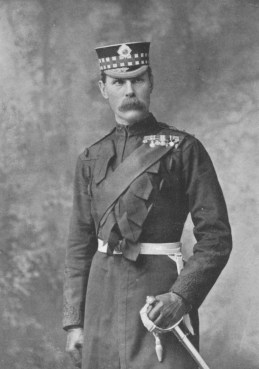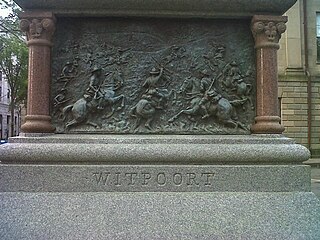
The Second Boer War, also known as the Boer War, Transvaal War, Anglo–Boer War, or South African War, was a conflict fought between the British Empire and the two Boer republics over the Empire's influence in Southern Africa.

The 1st Division is an infantry division of the British Army that has been formed and disestablished numerous times since 1809 and is still currently active as the 1st Division. Lieutenant-General Arthur Wellesley raised the division for service in the Peninsular War, which was part of the Coalition Wars of the Napoleonic Wars. The division was disestablished in 1814 but reformed the following year for service in the War of the Seventh Coalition. It then fought at the Battle of Waterloo, where it repulsed numerous attacks, including the final attack of the day that was launched by the French Imperial Guard. Following the battle, the division marched into France and became part of the Army of Occupation before being disbanded a few years later.
Lindley is a small town situated on the banks of the Vals River in the eastern region of the Free State province of South Africa. It was named after an American missionary, Daniel Lindley, who was the first ordained minister to the Voortrekkers in Natal. Basotho call it Ntha, after the river.

The SecondBattle of Colenso, also known as the Battle of Colenso, was the third and final battle fought during the Black Week of the Second Boer War. It was fought between British and Boer forces from the independent South African Republic and Orange Free State in and around Colenso, Natal, South Africa on 15 December 1899.

The Battle of Paardeberg or Perdeberg was a major battle during the Second Anglo-Boer War. It was fought near Paardeberg Drift on the banks of the Modder River in the Orange Free State near Kimberley.

The Battle of Magersfontein was fought on 11 December 1899, at Magersfontein, near Kimberley, South Africa, on the borders of the Cape Colony and the independent republic of the Orange Free State. British forces under Lieutenant General Lord Methuen were advancing north along the railway line from the Cape to relieve the siege of Kimberley, but their path was blocked at Magersfontein by a Boer force that was entrenched in the surrounding hills. The British had already fought a series of battles with the Boers, most recently at Modder River, where the advance was temporarily halted.

The Battle of Elandslaagte took place during the Second Boer War, and was one of the few clear-cut tactical victories won by the British during the conflict. However, the British force retreated afterwards, throwing away their advantage.

The Battle of Berg-en-dal took place in South Africa during the Second Anglo-Boer War.

The Battle of Diamond Hill (Donkerhoek) was an engagement of the Second Boer War that took place on 11 and 12 June 1900 in central Transvaal.
The Battle of Rooiwal was an engagement of the Second Boer War. It took place on 11 April 1902 and resulted in a victory by a British force commanded by Colonel Robert Kekewich over a Boer commando led by Generals Ferdinandus Jacobus Potgieter and Jan Kemp.

In the Battle of Nooitgedacht on 13 December 1900, Boer commandos led by Generals Koos de la Rey and Christiaan Beyers combined to deal a defeat to a British brigade under the command of Major General R. A. P. Clements during the Second Boer War.

The Battle of Bakenlaagte in Eastern Transvaal, South Africa, occurred on 30 October 1901 during the guerrilla phase of Anglo-Boer war of 1899–1902. The battle saw the Eastern Transvaal Boer commandos of Generals Johan Grobler, Coen Brits, Piet Viljoen and Louis Botha attack the rearguard of Colonel Benson's much feared No. 3 Flying Column while it was in marching formation to its base camp. On the Boer side general Daniel Opperman was killed in the engagement. The Bakenlaagte battlefield is located on the Kriel-Kinross road at the intersection of the R547 and R580 roads in Mpumalanga Province, just south of Matla Power Station.

The military history of Australia during the Boer War is complex, and includes a period of history in which the six formerly autonomous British Australian colonies federated to become the Commonwealth of Australia. At the outbreak of the Second Boer War, each of these separate colonies maintained their own, independent military forces, but by the cessation of hostilities, these six armies had come under a centralised command to form the Australian Army.

The Battle of Elands River was an engagement of the Second Boer War that took place between 4 and 16 August 1900 in western Transvaal. The battle was fought at Brakfontein Drift near the Elands River between a force of 2,000 to 3,000 Boers and a garrison of 500 Australian, Rhodesian, Canadian and British soldiers, which was stationed there to protect a British supply dump that had been established along the route between Mafeking and Pretoria. The Boer force, which consisted of several commandos under the overall leadership of Koos de la Rey, was in desperate need of provisions after earlier fighting had cut it off from its support base. As a result, it was decided to attack the garrison along the Elands River in an effort to capture the supplies located there.

The Battle of Witpoort was fought during the Second Anglo-Boer War. Major Frederick Henry Munn commanded the detachment of the Royal Irish Fusiliers at Witpoort which was attacked on 16 July 1900, his orders being to "hold his position at all costs". The Boers called on Major Munn to surrender, but, scornfully refusing, he held out from daybreak till 2 pm, when the Canadian forces mounted a counterattack and the Boers retired. The battle became famous because of the death of Harold Lothrop Borden.
Captain Percy Frederic Hunt was French-born, British army officer who was killed in action by the Letaba Commando at Duivelskloof during the Second Boer War. After Hunt's death, his subordinate and close friend, Lt. Harry Morant, responded with a series of revenge killings of both POWs and many local civilians. This led directly to the Court-martial of Breaker Morant, one of the first war crimes prosecutions in British military history.

General Jacobus Philippus Snyman was one of the dominant military figures in the South African Republic during the 19th century. He was the District Commissioner, Native Commissioner, and Commandant for the Marico district and led the Rustenburg and Marico commandos during the Second Boer War. Nicknamed Hamerkop, Snyman came to international prominence as the military commander at the Siege of Mafeking from November 1899 to May 1900.
The 9th (Welsh) Battalion, Imperial Yeomanry was a unit of the British Imperial Yeomanry (IY) raised for service in the Second Boer War. Equipped as Mounted infantry, the battalion served in South Africa from April 1900 until the end of the war. Its companies took part in numerous anti-guerrilla 'drives' with mobile columns that eventually brought the war to an end.
The Battle of Faber's Put, also known as the Battle of Faber's Pass was fought during the Second Boer War on the night of May 29–30, 1900.

The Northern Natal Offensive was a military invasion of the Northern region of Natal by the Boers of the Transvaal and the Orange Free State during the Second Boer War. It was part of a larger offensive by the Boers into the British colonies, with other invasions occurring in Bechuanaland and the Cape Colony. The Boers invaded on 12 October, after Paul Kruger had declared war a day earlier. The Boers initially had success with this offensive, besieging Ladysmith, and reaching as far south as Estcourt in November 1899. The goal of the offensive for the Boers was to reach the port city of Durban and the capital of Pietermartizburg in order hopefully force the British into peace negotiations. However, with Redvers Buller's reinforcements arriving that same month, the Boers retreated to the Tugela River. Multiple attempts were made by Buller to relieve Ladysmith, but to no avail. However, the fourth attempt in February 1900 expelled the Boers from their position at the Battle of the Pieters. Scattered fighting from March-May 1900 continued, with the Boers being expelled from Natal completely at the Battle of Laing's Nek. With the Boers out of Natal, the offensive ended.















